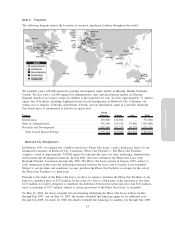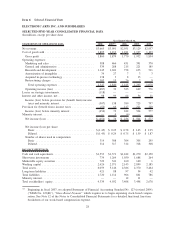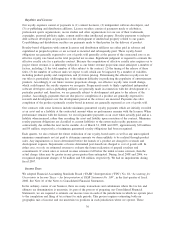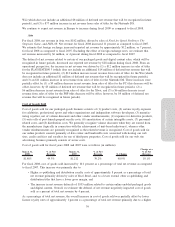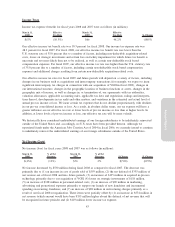Electronic Arts 2008 Annual Report Download - page 109
Download and view the complete annual report
Please find page 109 of the 2008 Electronic Arts annual report below. You can navigate through the pages in the report by either clicking on the pages listed below, or by using the keyword search tool below to find specific information within the annual report.
recognition of revenue based on the criteria set forth in Statement of Position (“SOP”) 97-2, “Software
Revenue Recognition”, as amended by SOP 98-9, “Modification of SOP 97-2, Software Revenue Recognition,
With Respect to Certain Transactions” and SAB No. 104, “Revenue Recognition”. We evaluate and recognize
revenue when all four of the following criteria are met:
•Evidence of an arrangement. Evidence of an agreement with the customer that reflects the terms and
conditions to deliver products that must be present in order to recognize revenue.
•Delivery. Delivery is considered to occur when a product is shipped and the risk of loss and rewards of
ownership have been transferred to the customer. For online game services, delivery is considered to
occur as the service is provided. For digital downloads that do not have an online service component,
delivery is considered to occur generally when the download occurs.
•Fixed or determinable fee. If a portion of the arrangement fee is not fixed or determinable, we
recognize revenue as the amount becomes fixed or determinable.
•Collection is deemed probable. We conduct a credit review of each customer involved in a significant
transaction to determine the creditworthiness of the customer. Collection is deemed probable if we
expect the customer to be able to pay amounts under the arrangement as those amounts become due. If
we determine that collection is not probable, we recognize revenue when collection becomes probable
(generally upon cash collection).
Determining whether and when some of these criteria have been satisfied often involves assumptions and
judgments that can have a significant impact on the timing and amount of revenue we report in each period.
For example, for multiple element arrangements, we must make assumptions and judgments in order to:
(1) determine whether and when each element has been delivered; (2) determine whether undelivered products
or services are essential to the functionality of the delivered products and services; (3) determine whether
VSOE exists for each undelivered element; and (4) allocate the total price among the various elements we
must deliver. Changes to any of these assumptions or judgments, or changes to the elements in a software
arrangement, could cause a material increase or decrease in the amount of revenue that we report in a
particular period. For example, in connection with some of our packaged goods product sales, we offer an
online service without an additional fee. Prior to fiscal 2008, we were able to determine VSOE for the online
service to be delivered; therefore, we were able to allocate the total price received from the combined product
and online service sale between these two elements and recognize the related revenue separately. However,
starting in fiscal 2008, VSOE does not exist for the online service to be delivered for certain platforms and all
revenue from these transactions are recognized over the estimated online service period. More specifically,
starting in fiscal 2008, we began to recognize the revenue from sales of certain online-enabled packaged goods
on a straight-line basis over a six month period beginning in the month after shipment. Accordingly, this
relatively small change (from having VSOE for the online service to no longer having VSOE) has had a
significant effect on our reported results.
Determining whether a transaction constitutes an online game service transaction or a download of a product
requires judgment and can be difficult. The accounting for these transactions is significantly different. Revenue
from product downloads is generally recognized when the download occurs (assuming all other recognition
criteria are met). Revenue from online game services is recognized as the services are rendered. If the service
period is not defined, we recognize the revenue over the estimated service period. Determining the estimated
service period is inherently subjective and is subject to regular revision based on historical online usage.
Product revenue, including sales to resellers and distributors (“channel partners”), is recognized when the
above criteria are met. We reduce product revenue for estimated future returns, price protection, and other
offerings, which may occur with our customers and channel partners. Price protection represents the right to
receive a credit allowance in the event we lower our wholesale price on a particular product. The amount of
the price protection is generally the difference between the old price and the new price. In certain countries,
we have stock-balancing programs for our PC and video game system products, which allow for the exchange
of these products by resellers under certain circumstances. It is our general practice to exchange products or
give credits rather than to give cash refunds.
Annual Report
33


